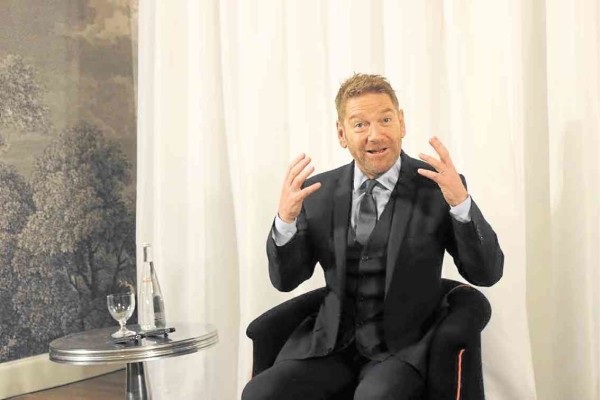LOS ANGELES—The lineup of actors, costumed in 1930s finery, who walked in one by one in this huge tent at Longcross Studios in Surrey, England, was staggering: Judi Dench, Penelope Cruz, Michelle Pfeiffer, Willem Dafoe, Daisy Ridley, Derek Jacobi, Josh Gad, Olivia Colman and Kenneth Branagh, to mention a few.
Kenneth, sporting an immense mustache as Hercule Poirot during our set visit last February, had the double challenge of acting as the legendary Belgian detective while directing the star-studded cast of “Murder on the Orient Express” that includes Johnny Depp.
The actor-filmmaker also had the challenge of overseeing this huge production that involved the construction of a fully moving train, complete with lavish interiors, a majestic Stamboul (Istanbul) train station with huge columns, working tracks and platforms, and other elaborate sets on Longcross’ largest soundstages.
We walked through one of the carriages built for this latest adaptation of Agatha Christie’s thrilling whodunit aboard a train traveling through Europe.
It was the elegant dining salon with a real kitchen and tables bedecked with real cutlery, crockery and glassware.
All of this 1930s splendor was shot by Kenneth using the last four 65mm Panavision cameras in the world. He also filmed on location in Malta.
Kenneth recently showed us footage of his work-in-progress at the Ham Yard Hotel in London.
The stunning footage left us wishing we could see the finished film that day. The film, produced by Ridley Scott, also stars Lucy Boynton, Tom Bateman, Manuel Garcia-Rulfo, Leslie Odom Jr., Sergei Polunin and Marwan Kenzari.
Sporting his own facial hair, the multiple Oscar and Golden Globe nominee sat down to look back and talk about his experience directing and acting in “Murder on the Orient Express.”
Before taking on Hercule Poirot, Kenneth played another detective—a Swedish one—in the well-received “Wallander.”
Excerpts from our chat:
Who was the first person you cast? Judi Dench. I went to ask her if she would do it. I hadn’t finished the question when she said “yes.”
Can you talk about the fun—and challenge—you had directing such a huge, immensely talented cast? There’s a lot of logistics involved, but they are a lovely group, aren’t they? You can also tell that that’s a group with rapport.
A really critical component was Judi Dench. Judi is like a talismanic figure. Derek and Judi know each other from a thousand years ago. Johnny has worked with Judi, and he worships her. She does have trouble seeing, but she never complains about it.
She is entirely gallant about her own stuff. She is entirely even-handed. There is no difference between her and anybody in any particular walk of life, job or anything.
Michelle Pfeiffer came up to me on the first day. They were all milling outside the train. It was like seeing a first day at school, people being shy and some people holding back a bit.
I thought, oh God, somebody has upset Michelle, but she said, “I love Judi Dench so much. I can’t believe I just met her.” I said, “Well, you are going to act with her in a minute.”
And what that did to the scenes was that it kept them very much alive. One thing I tried to do was never waste their time. Always get them when they are in that mood. Get them on the train and shoot quickly, because that is 16 actors times 16 makeup artists by 16 costume assistants.
So that becomes a bloody train carriage. You catch them while their excitement is high. It’s a bit like athletes. They are warmed up, ready to go. But Judi was an enormous help in being an example of how it could be serious, fun and kind.
Many people know the story’s ending. So, how did you keep the suspense level up? Keeping the environment lethal is important. As soon as you walk up and down the train, it’s not as simple as it seems.
We could, in that scenario, get some value out of just the various lethal objects that might be around on a moving thing. It goes quickly, and we put it in a slightly more dangerous environment than it might otherwise be.
As you can tell by the footage that we showed this morning, it’s not nearly a snowdrift that stops them. It’s something much more violent, which also leaves them marooned in a viaduct, which you saw when you visited the set.
There’s the sense of jeopardy about what might happen to the train, that the viaduct might collapse, etc.
From the acting point of view, we wanted to create as much paranoia and suspicion as we could.
But to your point about the end of the movie and people’s familiarity or not with that, the who, the how and the why were really important. The why becomes something that gives us great suspense.
That is an enormous mustache in the film. Did having that mustache make people on the set talk to you more? Well, it’s interesting. Of all the time when I have directed and acted, this one felt like a particularly good fit because there’s something about directing that seemed to have a parallel in conversations that I have had with real detectives while doing “Wallander.” I ended up having quite a number of conversations with policemen and see how they interview people.
As a director, you have to offer suggestions very clearly, and you need to listen carefully.
I remember when we first rehearsed with Derek. He said, “Christ, that’s an incredible stare you have.”
In fact, I was listening as carefully as Poirot did to the nearest nuance. But as a director, I also needed to be able to offer something back up to Derek.
While I am doing that, he can’t necessarily know what I am thinking. So you become this weird kind of positive, neutral, listening thing. Your curiosity, in a way, becomes a [form of] protection.
E-mail rvnepales_5585@yahoo.com. Follow him at https://twitter.com/nepalesruben.


